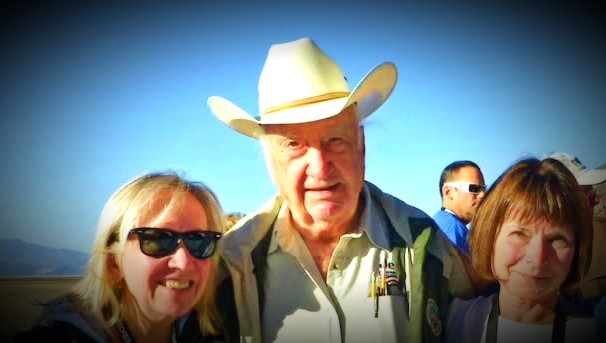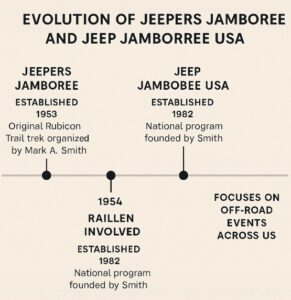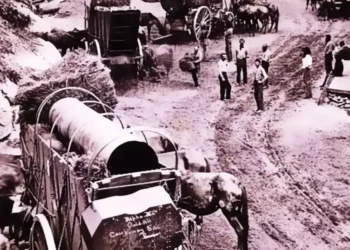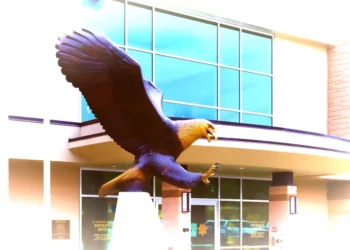By Cris Alarcon, InEDC Writer. (May 3, 2025)
GEORGETOWN, Calif. (InEDC) — The Rubicon Trail, a 22-mile off-road route stretching from Georgetown to Lake Tahoe, holds a storied place in the annals of off-roading history. Known today as one of the most challenging and iconic four-wheel-drive trails globally, its origins are deeply rooted in El Dorado County’s rich past.
From Native Pathways to Gold Rush Routes
Long before the advent of motorized vehicles, the area encompassing the Rubicon Trail was traversed by Native American tribes, notably the Washoe, who used these paths for seasonal migrations and trade. With the onset of the California Gold Rush in the mid-19th century, the trail evolved into a vital route for miners and settlers moving between Georgetown and the Lake Tahoe Basin. By the late 1800s, the trail facilitated access to resorts like Wentworth Springs and Rubicon Springs, becoming a popular destination for tourists seeking the therapeutic allure of natural hot springs.
The Birth of Modern Off-Roading
The transformation of the Rubicon Trail into a mecca for off-road enthusiasts is largely credited to Mark A. Smith.
Mark A. Smith, known as the ‘father of modern four-wheeling,’ founder of Jeep Jamboree USA and Mark A. Smith Off-Roading Inc., began his empire right here in Georgetown.
In 1951, Smith and his wife honeymooned in Georgetown and were captivated by the region’s rugged beauty. Two years later, in 1953, Smith organized the inaugural Jeepers Jamboree, leading 55 Willys Jeeps across the treacherous Sierra Nevada terrain via the Rubicon Trail. This event not only showcased the capabilities of four-wheel-drive vehicles but also laid the foundation for organized off-road recreation.
Mark had rediscovered an unmaintained stagecoach road on a fishing trip, and fell in love with it, calling it Shangri-la. In 1953, he and some Rotarian friends organized the first annual Jeep trek across the Sierra to Lake Tahoe on the Rubicon as an early tourism strategy to attract visitors to the region.
“In 1953, when Mark Smith organized the first Jeepers Jamboree with 55 Willys and voyaged across the Sierra Nevada Mountains by way of the Rubicon Trail, off-road recreation was born,”
said Pearse Umlauf, president and CEO of Jeep Jamboree USA.
A Legacy Carved in Granite
Following the success of the initial Jamboree, Willys Motors, the manufacturer of Jeep vehicles at the time, became involved in 1954, further cementing the trail’s status in off-roading culture. Over the decades, the Rubicon Trail has hosted numerous events, including the annual Jeepers Jamboree and Jeep Jamboree USA, drawing enthusiasts from around the globe eager to tackle obstacles like “Gatekeeper,” “Little Sluice,” and “Cadillac Hill.”
Smith’s influence extended beyond the trail. In 1979, he led the Expedicion de las Americas, a groundbreaking journey from the southern tip of South America to Prudhoe Bay, Alaska. In 1987, he founded Jeep Jamboree USA to organize off-road treks nationwide.
Preservation and Continued Adventure
Today, the Rubicon Trail remains a testament to the spirit of adventure and the enduring legacy of those who pioneered off-road exploration. Managed through a collaboration between El Dorado County, the U.S. Forest Service, and organizations like Friends of the Rubicon, efforts continue to preserve the trail’s natural beauty while accommodating the growing community of off-road enthusiasts.
For those seeking to experience the trail’s majesty without venturing into its more challenging sections, the trailheads at Loon Lake and Lake Tahoe’s west shore offer accessible opportunities for camping, hiking, and soaking in the breathtaking Sierra Nevada vistas.
The Rubicon Trail in California is one of the most famous off-road vehicle trails in the world, revered by adventurers, Jeep enthusiasts, and history buffs alike. Spanning over 22 miles across rugged granite terrain in the Sierra Nevada, the trail is steeped in Native American history, Gold Rush-era development, and 20th-century off-roading lore.
“Jeepers Jamboree was first in 1953. Jeep Jamboree was a entirely new company started by my father in 1982”
-Patti Smith Rubick.
Key Difference Between Jeep Jamboree and Jeepers Jamboree:
1. Jeepers Jamboree (Est. 1953):
-
Founded by Mark A. Smith in Georgetown, CA, this was the original organized trek across the Rubicon Trail.
-
It began as a local tourism initiative backed by the Georgetown Rotary Club and focused on bringing adventurers together to explore the Sierra by Jeep.
-
It is known for its party-like, rugged atmosphere — featuring live music, steak dinners, and a more laid-back, “old-school” approach to off-roading.
-
Still operates annually, based in Georgetown, and emphasizes fun, tradition, and community.
-
Website: jeepersjamboree.com
“Jeepers Jamboree is the original and most challenging Jeep trip of its kind in the world. It’s not just a trail ride — it’s an adventure,” — Jeepers Jamboree website
2. Jeep Jamboree USA (Est. 1982):
-
Also founded by Mark A. Smith, but almost 30 years later, to create a more family-friendly, national off-roading program.
-
This became a corporate partnership with Jeep® (then under AMC), creating a structured series of events across the country.
-
Focused on education, safety, and the off-road experience — and it became more aligned with Jeep’s branding efforts.
-
Operates 31+ trips annually in various states beyond California.
-
Website: jeepjamboreeusa.com
“Jeep Jamboree USA brings together the outdoors, off-roading, and friendship across the country, with trails for every level of driver,” — Pearse Umlauf, President & CEO of JJUSA
In Summary:
-
Jeepers Jamboree = Original, Rubicon-only, fun-loving and traditional
-
Jeep Jamboree USA = National, corporate, instructional, and family-focused.
Early History: Native Americans and the Gold Rush
Indigenous Use
-
The area around the Rubicon Trail was originally inhabited by the Washoe tribe, who used the trail corridor for seasonal migration and trade.
-
The name “Rubicon” was borrowed from the Latin term referring to a point of no return, but local Native Americans knew the area long before Euro-American settlers arrived.
Gold Rush and Wagon Routes (Mid-1800s)
-
During the California Gold Rush (1848–1855), the Sierra Nevada became a hotspot for mining activity.
-
The Rubicon corridor began as a primitive wagon trail used by miners and settlers seeking to cross the Sierra from Georgetown (El Dorado County) to Lake Tahoe.
-
In the 1860s, it served as a travel and supply route linking Georgetown to the Tahoe Basin, and ultimately to Carson City, Nevada.
The Resort Era and Tourism Development (Late 1800s–Early 1900s)
-
In 1887, the Rubicon Springs Resort was developed near the end of the trail near Lake Tahoe, offering hot springs, hunting, and fishing for early tourists.
-
The trail became a leisure destination for horse-drawn carriages, attracting wealthy visitors to the resort.
-
During this time, the route was maintained more as a private toll road than a public right-of-way, and it became popular for excursions and early automotive tourism.
Rise of Off-Roading and the Jeep Era (Mid-1900s)
Jeepers Jamboree (1953)
-
The modern off-road legacy began with the first organized Jeepers Jamboree in 1953, founded by Mark A. Smith, a Georgetown hotel owner and off-roading enthusiast.
-
Smith organized a group of 155 people in 55 Jeeps to make the trip from Georgetown to Rubicon Springs, solidifying the trail’s reputation as the ultimate 4×4 challenge.
-
The Jamboree became an annual tradition and helped define the off-road culture in the United States.
Trail Challenges and Upgrades
-
The trail traverses granite slabs, boulder fields, stream crossings, and steep climbs, with obstacles like:
-
Gatekeeper
-
Little Sluice
-
Walker Hill
-
Cadillac Hill
-
-
These features evolved naturally but have been maintained and modified over the years to balance environmental concerns with recreational access.
Environmental Concerns and Land Management (Late 20th Century–Present)
Public and Private Land
-
The Rubicon Trail crosses a mix of public lands (mostly Eldorado National Forest) and private property.
-
Management of the trail has been a collaboration between El Dorado County, the U.S. Forest Service, and organizations like Friends of the Rubicon (FOTR).
Environmental Controversy and Cleanup
-
In the early 2000s, concerns grew about erosion, water quality, and waste from heavy trail use.
-
In 2004, the Central Valley Regional Water Board issued a Cleanup and Abatement Order.
-
In response, major conservation and trail maintenance efforts began:
-
Installation of vault toilets
-
Creation of drainage systems
-
Volunteer cleanup efforts led by off-road groups
-
Recognition as a World-Class Trail
-
Despite occasional closures and legal challenges, the Rubicon Trail remains open, maintained, and globally recognized.
-
It is often referred to as the “crown jewel” of 4×4 trails.
Cultural Impact and Legacy
-
The Rubicon Trail is to off-roading what Route 66 is to road tripping — a pilgrimage for Jeep and rock-crawling enthusiasts.
-
Jeep even named their most rugged vehicle trim, the Jeep Wrangler Rubicon, after this trail.
-
It’s become a rite of passage for overlanding, a test of skill, and a symbol of California’s rugged wilderness and adventurous spirit.
Key Facts at a Glance
| Feature | Description |
|---|---|
| Length | ~22 miles (Georgetown to Rubicon Springs) |
| Elevation | Up to 7,000+ feet |
| Location | El Dorado County to Lake Tahoe Basin |
| Established | Native use for centuries; resort era 1880s+ |
| First Jeep Jamboree | 1953 |
| Notable Sections | Little Sluice, Big Sluice, Cadillac Hill |
| Trail Status | Mixed-use, maintained trail with limited access |











